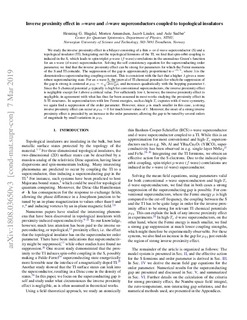Inverse proximity effect in s-wave and d-wave superconductors coupled to topological insulators
Journal article, Peer reviewed
Accepted version

Åpne
Permanent lenke
http://hdl.handle.net/11250/2635923Utgivelsesdato
2019Metadata
Vis full innførselSamlinger
- Institutt for fysikk [2695]
- Publikasjoner fra CRIStin - NTNU [38127]
Sammendrag
We study the inverse proximity effect in a bilayer consisting of a thin s- or d-wave superconductor (S) and a topological insulator (TI). Integrating out the topological fermions of the TI, we find that spin-orbit coupling is induced in the S, which leads to spin-triplet p-wave ( f -wave) correlations in the anomalous Green’s function for an s-wave (d-wave) superconductor. Solving the self-consistency equation for the superconducting order parameter, we find that the inverse proximity effect can be strong for parameters for which the Fermi momenta of the S and TI coincide. The suppression of the gap is approximately proportional to e−1/λ, where λ is the dimensionless superconducting coupling constant. This is consistent with the fact that a higher λ gives a more robust superconducting state. For an s-wave S, the interval of TI chemical potentials for which the suppression of the gap is strong is centered at μTI = ± √ 2mv2 Fμ, and increases quadratically with the hopping parameter t . Since the S chemical potential μ typically is high for conventional superconductors, the inverse proximity effect is negligible except for t above a critical value. For sufficiently low t , however, the inverse proximity effect is negligible, in agreement with what has thus far been assumed in most works studying the proximity effect in S-TI structures. In superconductors with low Fermi energies, such as high-Tc cuprates with d-wave symmetry, we again find a suppression of the order parameter. However, since μ is much smaller in this case, a strong inverse proximity effect can occur at μTI = 0 for much lower values of t . Moreover, the onset of a strong inverse proximity effect is preceded by an increase in the order parameter, allowing the gap to be tuned by several orders of magnitude by small variations in μTI. DOI: 10.1103/